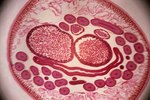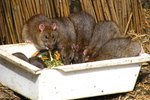
With at least 2,000 species, rodents are the largest group of mammals in the world. These diverse creatures live on all major continents except Antarctica, as well as most islands. They adapt to life in most any habitat and can be found from swamps and tropical rainforests to deserts. Some spend all their time high in trees, while others live underground and seldom venture above the surface. Wherever they are found, people often treat them as pests and nuisances, but they play important roles in the ecosystems they inhabit.
Source of Food
Nearly every kind of animal preys on rodents to some extent, including birds, reptiles, amphibians, other mammals and even fish. Rodents also play host to a number of parasites such as mites and ticks, creatures people may find just as problematic as the rodents themselves. All over the world, people have hunted and killed various rodent species for food. In Africa, poachers kill larger rodent species for meat when larger game has been exhausted.
Seed Spreaders
Biologists have long known that tropical forest rodents play a key role in spurring growth of new trees in the forest by spreading seeds. At least one African rodent, the Kivu giant pouched rat, has an equal responsibility in encouraging plant growth by dispersing seeds. They scatter-hoard larger seeds, as well as build sizable caches of seeds for later consumption that are often not consumed. Where the seeds germinate, they grow into new vegetation. Similar rodent behavior occurs in North America, where seeds sprout from stores made by burrowing rodents such as kangaroo rats and pocket mice. These creatures cache seeds along with other organic matter for winter consumption.
Soil Aerators
Many rodents such as ground squirrels, pocket gophers and prairie dogs bury underground, digging extensive burrows and tunnels. These tunnels not only create habitat for many other underground species, they also provide important benefits for the soil. Digging tunnels turns over the soil, mixing the top layers of litter and feces with the deeper layers. This process fertilizes the soil and buries carbon, essential for plant growth. The tunnels allow water to flow deep into the soil rather than running off, and also carry oxygen through sediment layers, aerating the soil to encourage root growth.
Fungus Distributors
Plants in forests have mutually beneficial relationships with fungi in the soil. Fungi provide plants with nutrients, while the plants give fungi energy to grow and reproduce. The seeds of some plants, like orchids, won't even germinate and sprout without being attached to a fungus. Rodents such as red squirrels and voles harvest and store mushrooms, exposing the spores to the elements and encouraging their spread. Underground fungi rely almost entirely on rodents to disperse their spores and reproduce. When the rodents eat their mushrooms, they distribute the fungal spores in their scat, facilitating another generation of healthy forest.
References
- University of Michigan Museum of Zoology: Animal Diversity Web: Rodentia
- University of Michigan Museum of Zoology: Animal Diversity Web: Muroidea
- Mongabay.com: Giant Rat Plays Big Ecological Role in Dispersing Seeds
- Juneau Empire: Rodents, Fungi and Other Small Wonders Play Big Role in Forest Chain
- U.S. Department of the Interior Bureau of Land Management National Science and Technology Center: Soil Biological Communities
Photo Credits
-
NA/AbleStock.com/Getty Images
Writer Bio
Jennifer Mueller began writing and editing professionally in 1995, when she became sports editor of her university's newspaper while also writing a bi-monthly general interest column for an independent tourist publication. Mueller holds a Bachelor of Arts in political science from the University of North Carolina at Asheville and a Juris Doctor from Indiana University Maurer School of Law.




